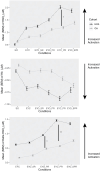Impact of sensory organization tasks on prefrontal cortex activity in older women: a comparative fNIRS study of osteoarthritis and healthy aging
- PMID: 40584181
- PMCID: PMC12202440
- DOI: 10.3389/fnagi.2025.1583447
Impact of sensory organization tasks on prefrontal cortex activity in older women: a comparative fNIRS study of osteoarthritis and healthy aging
Abstract
Introduction: Osteoarthritis (OA), a prevalent musculoskeletal condition, is associated with an increased risk of falls. Maintaining posture relies on visual, vestibular, and proprioceptive inputs, but these systems can be compromised due to aging or disease, heightening fall risk. Such impairments may result from neuromuscular decline and reduced cognitive or visuospatial processing abilities. This study aimed to investigate prefrontal cortical (PFC) activation patterns during clinical sensory organization tasks (SOT) using functional near-infrared spectroscopy (fNIRS) in older women with OA and healthy controls (HOA). We hypothesized that PFC activation would increase as SOT conditions became more challenging, but that increases would be limited in OA, relative to HOA, given a decreased attentional capacity due to chronic pain.
Methods: A cross-sectional study was conducted with 10 women with OA (65.7 ± 3.01 years) and 11 HOA (66.0 ± 4.86 years). Baseline cognitive and motor assessments preceded three trials of six SOT conditions.
Results: Significant differences between groups in BMI, WOMAC pain score, repeated chair stand, and TUG scores were found (p < 0.001). Linear mixed-model analysis revealed significant effects of condition (CND; p < 0.001), trial (TR; p < 0.0001), and interactions between CND*TR (p < 0.01) and Cohort*CND (p < 0.01) on PFC activation.
Discussion: In conclusion, both groups demonstrated increased PFC activation with task difficulty. However, OA participants exhibited diminished capacity to recruit additional attentional resources compared to HOA, emphasizing the need for further research with larger cohorts to elucidate these findings.
Keywords: balance; near infrared spectroscopy; osteoarthritis; prefrontal cortex; sensory organization task.
Copyright © 2025 Bishnoi, Hu and Hernandez.
Conflict of interest statement
The authors declare that the research was conducted in the absence of any commercial or financial relationships that could be construed as a potential conflict of interest.
Figures


Similar articles
-
Peripuberty Is a Sensitive Period for Prefrontal Parvalbumin Interneuron Activity to Impact Adult Cognitive Flexibility.Dev Neurosci. 2025;47(2):127-138. doi: 10.1159/000539584. Epub 2024 Jun 3. Dev Neurosci. 2025. PMID: 38830346 Free PMC article.
-
Exercise interventions and patient beliefs for people with hip, knee or hip and knee osteoarthritis: a mixed methods review.Cochrane Database Syst Rev. 2018 Apr 17;4(4):CD010842. doi: 10.1002/14651858.CD010842.pub2. Cochrane Database Syst Rev. 2018. PMID: 29664187 Free PMC article.
-
Celecoxib for osteoarthritis.Cochrane Database Syst Rev. 2017 May 22;5(5):CD009865. doi: 10.1002/14651858.CD009865.pub2. Cochrane Database Syst Rev. 2017. PMID: 28530031 Free PMC article.
-
Effectiveness and safety of vitamin D in relation to bone health.Evid Rep Technol Assess (Full Rep). 2007 Aug;(158):1-235. Evid Rep Technol Assess (Full Rep). 2007. PMID: 18088161 Free PMC article.
-
A rapid and systematic review of the clinical effectiveness and cost-effectiveness of paclitaxel, docetaxel, gemcitabine and vinorelbine in non-small-cell lung cancer.Health Technol Assess. 2001;5(32):1-195. doi: 10.3310/hta5320. Health Technol Assess. 2001. PMID: 12065068
References
-
- Centers for Disease Control and Prevention (2020). Osteoarthritis (OA). Available online at: https://www.cdc.gov/arthritis/osteoarthritis/index.html
LinkOut - more resources
Full Text Sources
Miscellaneous

